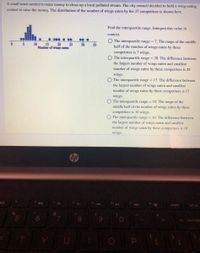
MATLAB: An Introduction with Applications
6th Edition
ISBN: 9781119256830
Author: Amos Gilat
Publisher: John Wiley & Sons Inc
expand_more
expand_more
format_list_bulleted
Question
Find the interquartile range . Interpret this value in context.

Transcribed Image Text:A small town needed to raise money to clean up a local polluted stream. The city council decided to hold a wing-eating
contest to raise the money. The distribution of the number of wings eaten by the 37 competitors is shown here.
Find the interquartile range. Interpret this value in
context.
• 000 0 00
O The interquartile range = 7. The range of the middle
half of the number of wings eaten by these
20
25
30
35
Number of wings eaten
competitors is 7 wings.
O The interquartile range = 28. The difference between
the largest number of wings eaten and smallest
number of wings eaten by these competitors is 28
wings.
O The interquartile range = 17. The difference between
the largest number of wings eaten and smallest
number of wings eaten by these competitors is 17
wings.
O The interquartile range = 10. The range of the
middle half of the number of wings eaten by these
competitors is 10 wings.
O The interquartile range = 10. The difference between
the largest number of wings eaten and smallest
number of wings eaten by these competitors is 10
wings.
h2
insert
prt sc
114 04
&
6.
backspa
CO
Expert Solution
This question has been solved!
Explore an expertly crafted, step-by-step solution for a thorough understanding of key concepts.
This is a popular solution
Trending nowThis is a popular solution!
Step by stepSolved in 2 steps

Knowledge Booster
Learn more about
Need a deep-dive on the concept behind this application? Look no further. Learn more about this topic, statistics and related others by exploring similar questions and additional content below.Similar questions
- A pediatrician wants to determine the relation that exists between a child's height, x, and head circumference, y. She randomly selects 11 children from her practice, measures their heights and head circumferences, and obtains the accompanying data. Complete parts (a) through (g) below. E Click the icon to view the children's data, Question Help ▼ Interpret the y-intercept, it approprate. Select the correct choice below and, it necessary, till in the answer box to complete your choice. O A. For every inch increase in head circumference, the height increases by in., on average. (Round to one decimal place as needed.) O B. For a height of 0 inches, the head circumference is predicted to be (Round to one decimal place as needed.) in. O C. For every inch increase in height, the head circumference increases by in., on average. (Round to one decimal place as needed.) O D. For a head circumference of 0 inches, the height is predicted to be in. (Round to one decimal place as needed.) O E. It…arrow_forwardDetermine whether the statement makes sense or does not make sense, and explain your reasoning : "My body temperature is a function of the time of day."arrow_forwardCould you please show me how to calcualte this (the circled one) on excel, I want the whole formula detail please the answer shown is correct.arrow_forward
arrow_back_ios
arrow_forward_ios
Recommended textbooks for you
 MATLAB: An Introduction with ApplicationsStatisticsISBN:9781119256830Author:Amos GilatPublisher:John Wiley & Sons Inc
MATLAB: An Introduction with ApplicationsStatisticsISBN:9781119256830Author:Amos GilatPublisher:John Wiley & Sons Inc Probability and Statistics for Engineering and th...StatisticsISBN:9781305251809Author:Jay L. DevorePublisher:Cengage Learning
Probability and Statistics for Engineering and th...StatisticsISBN:9781305251809Author:Jay L. DevorePublisher:Cengage Learning Statistics for The Behavioral Sciences (MindTap C...StatisticsISBN:9781305504912Author:Frederick J Gravetter, Larry B. WallnauPublisher:Cengage Learning
Statistics for The Behavioral Sciences (MindTap C...StatisticsISBN:9781305504912Author:Frederick J Gravetter, Larry B. WallnauPublisher:Cengage Learning Elementary Statistics: Picturing the World (7th E...StatisticsISBN:9780134683416Author:Ron Larson, Betsy FarberPublisher:PEARSON
Elementary Statistics: Picturing the World (7th E...StatisticsISBN:9780134683416Author:Ron Larson, Betsy FarberPublisher:PEARSON The Basic Practice of StatisticsStatisticsISBN:9781319042578Author:David S. Moore, William I. Notz, Michael A. FlignerPublisher:W. H. Freeman
The Basic Practice of StatisticsStatisticsISBN:9781319042578Author:David S. Moore, William I. Notz, Michael A. FlignerPublisher:W. H. Freeman Introduction to the Practice of StatisticsStatisticsISBN:9781319013387Author:David S. Moore, George P. McCabe, Bruce A. CraigPublisher:W. H. Freeman
Introduction to the Practice of StatisticsStatisticsISBN:9781319013387Author:David S. Moore, George P. McCabe, Bruce A. CraigPublisher:W. H. Freeman

MATLAB: An Introduction with Applications
Statistics
ISBN:9781119256830
Author:Amos Gilat
Publisher:John Wiley & Sons Inc

Probability and Statistics for Engineering and th...
Statistics
ISBN:9781305251809
Author:Jay L. Devore
Publisher:Cengage Learning

Statistics for The Behavioral Sciences (MindTap C...
Statistics
ISBN:9781305504912
Author:Frederick J Gravetter, Larry B. Wallnau
Publisher:Cengage Learning

Elementary Statistics: Picturing the World (7th E...
Statistics
ISBN:9780134683416
Author:Ron Larson, Betsy Farber
Publisher:PEARSON

The Basic Practice of Statistics
Statistics
ISBN:9781319042578
Author:David S. Moore, William I. Notz, Michael A. Fligner
Publisher:W. H. Freeman

Introduction to the Practice of Statistics
Statistics
ISBN:9781319013387
Author:David S. Moore, George P. McCabe, Bruce A. Craig
Publisher:W. H. Freeman